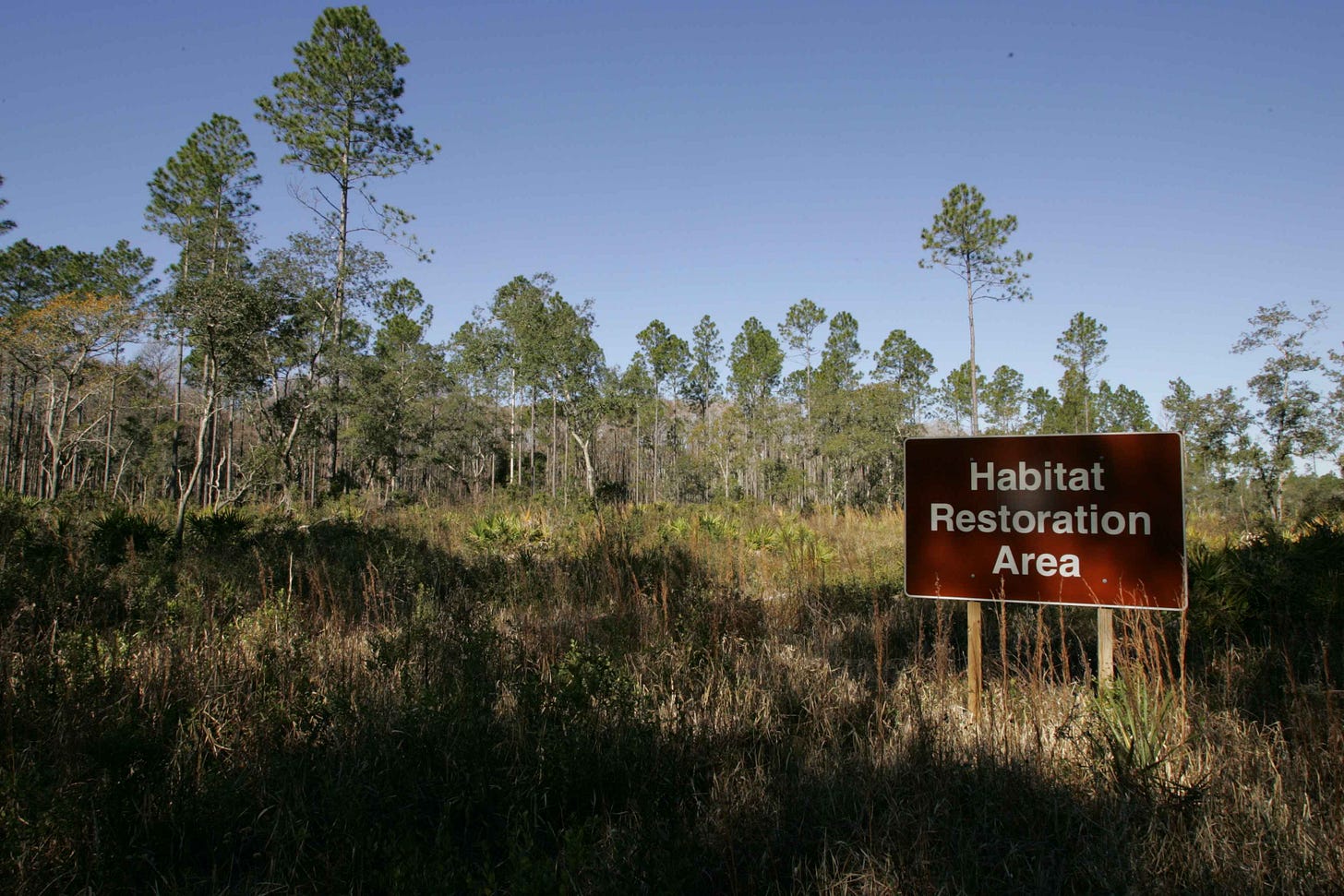The Framework
12/22/22 – a translation of the Global Biodiversity Framework’s 4 goals and 23 targets
Hello everyone:
A quick holiday funding note: To support the Field Guide to the Anthropocene and my work to bring you in-depth, thoughtful weekly explorations of this transformed world, please consider gifting a paid subscription to someone you care for. Maybe you have a hard-to-shop-for reader who’s looking for perspective on the world as it is, in all its beauty and crisis? Or a climate-focused environmentalist who would like to know more about the equally important work to be done for biodiversity? Or just someone who would appreciate good writing on hard topics?
Any gift subscription you purchase will support the many hours I put into the Field Guide, and will help me make this a (paid) full-time job. For those of you considering upgrading your free subscription to paid, this end-of-year holiday season is a great time to do so. I keep my writing available for all subscribers, regardless of their ability to pay. Your paid subscription, if you can afford it, helps make that happen.
To all of my readers, thank you for being here and for paying attention to this new world we’ve inherited and are passing on.
As always, please remember to scroll past the end of the essay to read some curated Anthropocene news.
Now on to this week’s writing:
I’m offering something a little different this week, less an essay than a document. And here’s something else a little different: I’m not known for my exclamation points, but I’ll start this week with two.
Happy Solstice! The tide of light has turned. The Earth’s northern half has reached the midpoint of its turn away from the Sun. This quiet moment in celestial affairs offers northerners firm ground for marking the new year. Neither calendar nor faith is required, only a close eye on the season we inhabit and a hope that with more light will come more clarity and warmth and the promise of better days.
We have a deal! Delegates in Montreal persisted through the political, ethical, and diplomatic impossibilities and ratified the Kunming-Montreal Global Biodiversity Framework, an extraordinarily important agreement between the nations (and Indigenous peoples) of the world to protect and preserve life on Earth. It is neither perfect nor binding, and it may, like its predecessors, fail completely. No doubt there will be at least some disturbing failures alongside some successes as governments struggle to live up to the deal.
But the existence of this document is a sign that we are working toward becoming a better species by choosing to care for our fellow travelers and for the ecosystems we all need to survive. The corporate, financial, and societal forces that drive the destruction of life on Earth are still running the show, but the Framework is a strong sign that the better angels of our nature can make Earth-shaking policy too.
The framework has 4 goals and 23 targets. You can read some good summaries from the Times, E&E News, and especially from Benji Jones at Vox, among others, and I recommend you do so.
What is harder to find is a full translation of every goal and target. Why does it need a translation? Because the writing is miserably bureaucratic: full of jargon, awkward phrasing, unclear language, and long terrible sentences.
I’ll provide a clear translation here, but be aware that I am trading some nuance for brevity. If you want to see the agreement in all its verbose glory, click here. To keep this copy clean, I’m not going to use quotation marks or otherwise indicate where I’m using their language.
My purpose here is to honor the original text while also giving you clarity and insight into what might prove to be the most important conservation document ever created:
THE KUNMING-MONTREAL GLOBAL BIODIVERSITY FRAMEWORK
GOALS:
A. i) Protect and improve the integrity, connectivity and resilience of all ecosystems, and increase the area of natural ecosystems by 2050; ii) Halt human-induced extinction of threatened species, reduce the extinction rate tenfold by 2050, and increase the abundance of native wild species; iii) Maintain genetic diversity of wild and domesticated species to safeguard their adaptive potential.
B. By 2050, ensure that biodiversity is sustainably used and managed in order to maintain nature’s contributions to people, including ecosystem functions and services. Restore ecosystems in decline to support sustainable development for the benefit of present and future generations.
C. By 2050, fairly and equitably share the monetary and non-monetary benefits from the utilization of genetic resources with indigenous peoples and local communities, while ensuring traditional knowledge associated with genetic resources is appropriately protected.
D. Ensure that all Parties have adequate means to implement the Kunming-Montreal Global Biodiversity Framework, including financial resources, capacity-building, technical and scientific cooperation, and access to and transfer of technology. Close the biodiversity finance gap of US$700 billion per year, and align financial flows with the Kunming-Montreal Global Biodiversity Framework and the 2050 Vision for Biodiversity.
TARGETS: (For the Targets, I’ll also put a key phrase in bold to help identify its primary idea)
1. By 2030, to ensure that the land and sea areas of the world are mapped and/or managed for their biodiversity, and to bring the loss of important biodiversity areas close to zero, while respecting the rights of indigenous peoples and local communities.
2. By 2030, to have at least 30% of degraded terrestrial, inland water, and coastal and marine ecosystems under effective restoration for enhanced biodiversity and ecosystem functions.
3. By 2030, to effectively conserve and manage at least 30% of terrestrial, inland water, coastal and marine areas, especially areas of particular importance for biodiversity, while recognizing and respecting the rights of indigenous peoples and local communities.
4. To halt human-induced extinction of known threatened species, to significantly reduce extinction risk, to maintain and restore the genetic diversity within and between populations of native, wild and domesticated species, and to improve coexistence by managing human-wildlife conflict.
5. To ensure that the harvest and trade of wild species is sustainable, safe and legal, to minimize impacts on non-target species and ecosystems, and to reduce the risk of pathogen spill-over while respecting sustainable use by indigenous peoples and local communities.
6. By 2030, to reduce and mitigate the impacts of invasive alien species on biodiversity and ecosystem services, to eradicate invasive alien species in priority sites, such as islands, and to reduce the rates of introduction of other invasive alien species by at least 50%.
7. By 2030, to reduce pollution impacts on biodiversity and ecosystems by reducing excess nutrients lost to the environment by at least 50%, reducing the overall risk from pesticides and highly hazardous chemicals by at least 50%, and working to eliminate plastic pollution.
8. To minimize the impact of climate change and ocean acidification on biodiversity through mitigation, adaptation, and disaster risk-reduction actions, including nature-based solutions and ecosystem-based approaches.
9. To manage the use of wild species sustainably in order to provide social, economic and environmental benefits for all peoples, through activities, products, and services that enhance biodiversity, while protecting sustainable use by indigenous peoples and local communities.
10. To manage agriculture, aquaculture, fisheries, and forestry sustainably through biodiversity-friendly practices and strategies that increase food security and increase resilience, long-term efficiency, and productivity of these production systems.
11. To protect and restore nature’s contributions to people, such as regulation of air, water, and climate, soil health, pollination, and reduction of disease risk, as well as protection from natural hazards and disasters, through nature-based solutions and ecosystem-based approaches.
12. To improve human health and well-being by significantly increasing and improving green and blue spaces in urban and densely populated areas, mainstreaming conservation- and biodiversity-minded urban planning, and enhancing native biodiversity and ecological integrity.
13. To ensure the fair and equitable sharing of benefits that arise from the utilization of genetic resources and from digital sequence information on genetic resources, to honor traditional knowledge associated with genetic resources, and by 2030 to significantly increase the shared benefits.
14. To integrate biodiversity and its multiple values across all levels of government – policies, regulations, planning and development processes, poverty eradication strategies, strategic environmental assessments and, as appropriate, fiscal and financial flows – and to do so in coordination with the goals and targets of this framework.
15. To encourage and enable businesses, in particular large and transnational companies and financial institutions to (a) monitor, assess, and transparently disclose their risks, dependencies and impacts on biodiversity from their operations, supply chains, and portfolios; (b) provide biodiversity-related information to consumers to promote sustainable consumption patterns; (c) report on their compliance in order to progressively reduce negative impacts on biodiversity.
16. To encourage consumers to make sustainable choices by establishing supportive policy and regulatory frameworks, and by improving education and access to accurate information; and by 2030, to reduce the global footprint of consumption by halving global food waste, significantly reducing overconsumption, and substantially reducing waste generation.
17. To build and implement in all countries biosafety measures as set out in Article 8(g) of the Convention on Biological Diversity and measures for the handling of biotechnology and distribution of its benefits as set out in Article 19 of the Convention.
18. By 2025, to equitably phase out or reform subsidies harmful for biodiversity, progressively reducing them by at least US$500 billion per year by 2030, starting with the most harmful incentives, and scaling up positive incentives for the conservation and sustainable use of biodiversity.
19. By 2030, mobilizing at least US$200 billion per year to implement national biodiversity strategies, from domestic, international, public, and private resources, in accordance with Article 20 of the Convention, including by:
a. Increasing biodiversity-related international financial resources from developed countries to developing countries, in particular the least developed countries and small island developing States, to at least US$20 billion per year by 2025, and to at least US$30 billion per year by 2030;
b. Significantly increasing domestic resources through implementation of national biodiversity finance plans;
c. Leveraging private finance and encouraging the private sector to invest in biodiversity, including through impact funds and other instruments;
d. Stimulating innovative schemes such as payment for ecosystem services, green bonds, biodiversity offsets and credits, and benefit-sharing mechanisms;
e. Optimizing finance that targets both the biodiversity and climate crises;
f. Enhancing the role of collective actions, including by indigenous peoples and local communities, and non-market-based approaches aimed at the conservation of biodiversity;
g. Enhancing the effectiveness and efficiency of resource provision and use.
20. To strengthen biodiversity-related development and scientific research through technical and scientific cooperation so that all countries can effectively implement their programs for the conservation and sustainable use of biodiversity.
21. To ensure that the best available data, information, and knowledge are accessible to decision makers and the public in order to produce effective governance and participatory management of biodiversity; also, to ensure that the knowledge, practices, and technologies of indigenous peoples and local communities will only be accessed with their free, prior and informed consent.
22. To respect the biodiversity-related rights of indigenous peoples and local cultures, including their rights over lands, territories, resources, and traditional knowledge; to respect the rights of women and girls, children and youth, and persons with disabilities; and to ensure the full protection of environmental human rights defenders.
23. To ensure gender equality in implementing the global biodiversity framework by offering all women and girls equal opportunity and capacity to contribute to the three objectives of the Convention, by recognizing their equal rights, by providing right of access to land and natural resources, and by encouraging their full, equitable, meaningful and informed participation and leadership at all levels of decision-making related to biodiversity.
For those of you who made it through all that, remember that this is a much, much shorter and clearer version… Rewriting the bureaucratic word-salad was more work than I expected, to be honest, but I’m glad I did it. For all its quirks, repetitions, wordiness, and density, the global biodiversity framework is an astonishing document, if you think of it in terms of its aspirations. Nearly every nation on Earth just signed onto this thing.
There’s so much to say about the content of the framework and the fate of its aspirations, but I’m out of space and time. And perhaps it’s better to end this week instead with a look at the good work being done already to meet the goals and targets described here.
To that end, then, I’ll direct you to three sources: the UN Environment Program’s Decade on Ecosystem Restoration (specifically their recently announced 10 Flagship Initiatives), the illustrated report from Protected Planet that assesses “the state of protected and conserved areas around the world,” and Restor, a citizen-science mapping tool showing where on Earth people have done or are doing habitat restoration and ecosystem conservation. All three are heartwarming resources if what you need is a sign, beyond clapping delegates in a Montreal conference center, that plenty of good people are doing big important work on behalf of life.
Thanks for sticking with me.
In other Anthropocene news:
Here's an elegant, innovative idea I didn’t see coming: a battery-equipped induction cookstove for the home. It plugs into a regular 120v outlet, works when the power goes out, and in an outage can even power other appliances. Electric stoves have none of the indoor air pollution of gas stoves, and induction stoves boil faster and simmer more precisely. This innovation comes from a small start-up in San Francisco, so it will be quite a while before the idea spreads, but it’s exciting nonetheless.
From David Wallace-Wells in his Times opinion column, a very welcome wake-up call for those who think the climate crisis is the only important environmental issue. His piece, “Has Climate Change Blinded Us to the Biodiversity Crisis?”, speaks to one of the key ideas behind this Field Guide, that climate change is only one symptom of the Anthropocene.
There are about as many ladybug species as there are mammal species, and there are more weevil species than species of fish. Check out this really great illustrated explainer from Reuters, “The Collapse of Insects,” on the ongoing insect apocalypse. I highly recommend it for its smart and beautiful illustrations, and for its insights into the mind-boggling variety of insects. Then use it as motivation to provide habitat for insects. Start by not mowing at least part of your lawn.
From Hakai, the intelligence behind Indigenous shellfish gardens in the Pacific Northwest, which may offer some solutions for the effects of ocean acidification on coastal shellfish populations.
From the Times, “The Climate Impact of Your Neighborhood, Mapped.” This is a fascinating display of just how much less per capita impact there is in dense urban neighborhoods compared to wasteful, sprawling, suburban areas. Check it out and zoom in on your own zip code.
From Emergence, an hour-long audio interview with James Bridle, author of Ways of Being, the most exciting Anthropocene book on my couch-side stack.
From E&E News, two reports on good climate-related transportation policy coming down from the Biden administration: new EPA rules on heavy-duty trucks and engines, and an announcement from the US Post Office that they’re planning to purchase and deploy 66,000 electric delivery trucks by 2028.







Thank you, Jason, for the translation and for all the important good work you're doing!
Great work. Thanks for the translation, Jason.